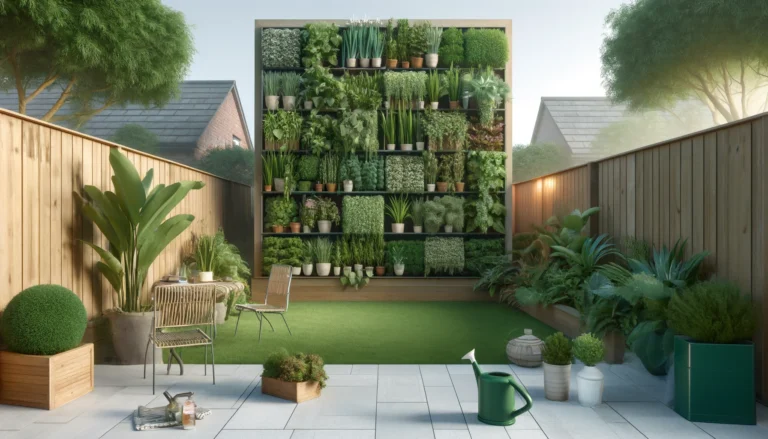Essential Tips for Maintaining a Japanese Garden
buddhaindooroutdoor.com participates in the Amazon Services LLC Associates Program, an affiliate advertising program designed to provide a means for sites to earn advertising fees by advertising and linking to Amazon.com.
A Japanese garden is not just plants and rocks. It is a story of harmony painted with greenery and pebbles. If you own such a garden, you might wonder how to keep it beautiful and thriving.
This guide offers key advice on Japanese garden care and garden maintenance tips. It covers everything from garden pruning techniques to essential garden health practices. Learn how to care for your Japanese garden with skill.
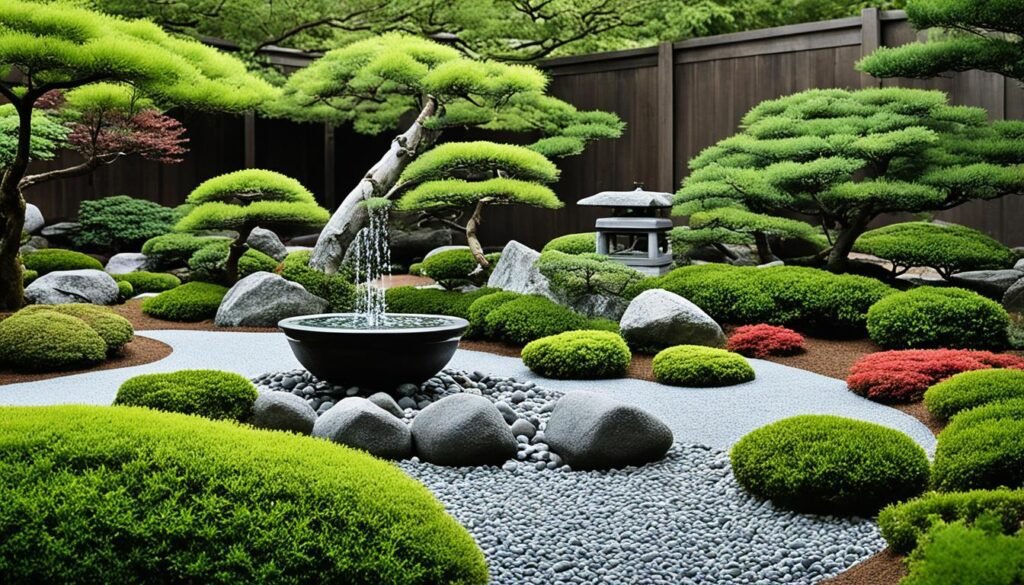
Whether you’re experienced or new to DIY Japanese garden maintenance, knowing the best practices for Japanese garden upkeep is crucial.
This guide provides a tailored care approach that respects its cultural significance. It also includes practical modern gardening tips. Let’s walk through how you can elevate your garden care from a mere routine to a meaningful ritual.
Key Takeaways
- Delving into the philosophical underpinnings of Japanese garden design for better maintenance.
- Mastering minimalist elements to maintain the garden’s harmony and balance.
- Employing traditional pruning techniques and plant care for sustained garden health.
- Understanding the importance of non-plant elements in garden aesthetics and maintenance.
- Considering outsourcing as a viable option for Japanese garden upkeep.
- Learning about optimizing irrigation systems for the ideal water balance.
Understanding the Philosophy Behind Japanese Garden Design
A Japanese garden pulls you into mindfulness and peace. It stands on the beliefs of Buddhism, Shinto, and Taoism. It’s not just about looks—it’s a spiritual spot that promotes reflection and connecting with nature.
Key pieces like water, plants, and rocks work together to make a calm place. By following these ideals, you can fill your garden with Japanese tranquility.
The art of Japanese gardens shows two main styles: the simpler, ornamental one and the one true to tradition. The second style focuses on real design elements that fit the landscape. It’s all about using local stuff and making the garden’s unique features stand out.
Japanese gardens have evolved, turning tea garden stepping stones from just useful to beautifully meaningful. This change was inspired by tea master Sen no Rikyu. It shows the blend of usefulness and beauty, which is key to the charm of Zen gardens.
Some people misunderstand Japanese gardens, especially in the West. True fans might not like unnecessary things like black ropes on trees. These don’t add to the garden’s real feel and are not very useful.
To understand Japanese garden philosophy, look at the simple Zen gardens. They use rocks, gravel, and few plants to symbolize nature’s beauty.
Rocks in Zen gardens represent unchanging elements, while the sand patterns stand for water’s movement. This suggests water’s presence without actually seeing it.
| Element | Functional Purpose | Aesthetic Value | Spiritual Significance |
|---|---|---|---|
| Tea Garden Stepping Stones | 60% – Guides the path | 40% – Adds visual rhythm | Encourages moment-to-moment awareness |
| Rocks in Zen Gardens | Strength and Stability | Harmonious compositions | Eternity and resilience of nature |
| Gravel and Sand | Represents water flow | Patterns for tranquility | Simplicity and purity of form |
| Plant Selection | Natural longevity | Enhances garden harmony | Reflects the unchanging aspect of existence |
Understanding these elements and their meanings ties your gardening to a long tradition. Whether making a Zen sanctuary or adding Japanese beauty, knowing the philosophy transforms your garden. It becomes a place of deep beauty and calm.
Creating Harmony with Minimalist Japanese Garden Elements
The essence of a Japanese garden lies in its union with nature, using minimalist design. It reflects Zen concepts, aiming for peace and beauty in simplicity. Keep in mind these key aspects if you’re adding Japanese touches to your space.
Japanese garden elements like rocks, water, and plants are carefully chosen to mirror natural landscapes. Each element, whether a main feature or a nod to tradition, is thoughtfully placed.
Strategic Placement of Rocks and Stones
Rocks and stones are crucial in these gardens, representing nature’s enduring nature. Their careful arrangement mimics mountains or symbolizes islands. The choice of rocks and stones depends on shape and texture, fitting the minimalist style.
Water Elements for Tranquility
Water adds movement and life, contrasting the solid rocks. A flowing stream, still pond, or waterfall adds a sensory layer. It brings soothing sounds and reflects the sky.
Integrating Artful Topiaries
Artful topiaries introduce refined greenery. Pruned trees and shrubs are each a work of art, inviting reflection. They enhance the garden’s beauty and philosophical meaning.
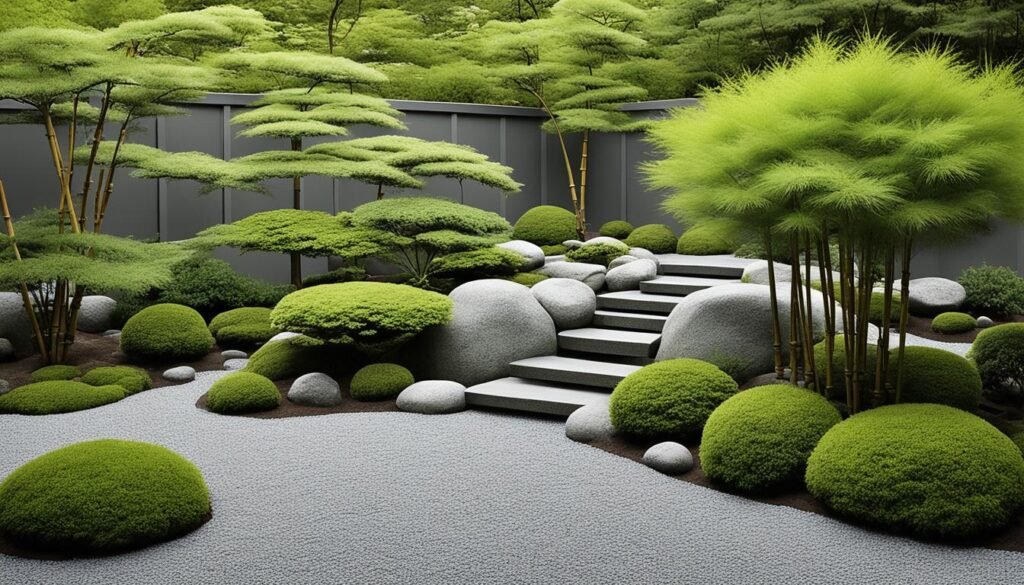
Incorporating these elements aims for harmony between natural and minimalist. They enhance each other, offering a grounded yet uplifting experience.
Below is a table showing how minimalist Japanese gardens balance their elements:
| Element | Significance | Design Tips |
|---|---|---|
| Rocks and Stones | Symbolize mountains and islands. | Choose varied sizes and shapes for a more natural look. |
| Water Features | Embody the fluctuating yet constant nature of life. | Incorporate a small pond or stream to add tranquility. |
| Topiaries | Represent man’s connection and influence over nature. | Shape trees and shrubs to mimic natural forms or patterns. |
By embracing these minimalist principles, your space will please the eye and enrich the soul. It captures the true essence of a Japanese garden.
Mastering the Balance of Open Space in Your Garden
The heart of open space in Japanese gardens is its quiet beauty. It gives room for deep thoughts and calm. Such gardens are carefully made to look natural and inviting. The open space serves as a mental canvas, creating peace.
Planning Your Viewing Angles
Viewing angles in gardens make each look special. They mix buildings with nature beautifully. Paths, plants, and water tell a story. ZEN Associates believes a well-planned view turns gardens into a magical scene.
Steppingstones and Path Creation
Steppingstones are key in path creation. They guide visitors on a moving meditation. The space between each stone adds rhythm to your walk. Every step is an invitation to be fully present.
| Element | Purpose | Design Principle |
|---|---|---|
| Open Space | Invites tranquility and perspective | Balance and Asymmetry |
| Viewing Angles | Offers unique perspectives | Naturalness and Simplicity |
| Steppingstones | Guides visitors and controls pace | Wabi-Sabi and Flow |
Designing a Japanese garden needs insight and purpose. Focusing on open space and careful planning makes a garden beautiful and soulful.
ZEN Associates recommend local plants for sustainability and beauty. This makes your garden both Eco-friendly and true to Japanese values.
Maintaining a Japanese Garden
To take care of a Japanese garden, you need to know its special design and the need for careful upkeep. Adding rock gardens, using plants like bamboo for beauty, and traditional elements like a zigzag bridge to keep away evil spirits are key. These features make the garden need regular care.
| Feature | Description | Maintenance Advice |
|---|---|---|
| Bamboo Plants | Used for structural beauty and a sense of privacy. | Prune to control spreading and remove aged canes. |
| Zigzag Bridge | Symbolic feature for protection and aesthetic. | Inspect for stability and wood decay annually. |
| Reflecting Pool | A serene water feature adding depth. | Clean regularly, monitor water quality and clarity. |
As you work on caring for a Japanese garden, include plants like hostas, Hakone grass, and Japanese maple trees.
Each plant needs different care, from pruning to checking soil moisture. Stepping stones and moss show the need for us to walk and take care of the garden gently.
Despite what some think, experts say Japanese gardens need regular care. This keeps the garden’s spirit alive.
Over 200 Japanese-style public gardens in the United States tell many maintenance stories. Places like the Portland Japanese Garden show how to arrange rocks and choose local plants wisely. This approach is key for looking after these beautiful spaces.
Remember, maintaining a Japanese garden means balancing beauty with caring for the environment. It’s about respecting the land and keeping our spaces connected. This philosophy leads gardeners to focus on authenticity, beyond just adding lanterns and water basins.
- Avoid invasive species to lessen maintenance and help the ecosystem by choosing native plants.
- Use ground-covers like moss to reduce weeding and preserve soil moisture, following Japanese gardening principles.
- Collect rainwater for irrigation to cut down on water use and support sustainable gardening.
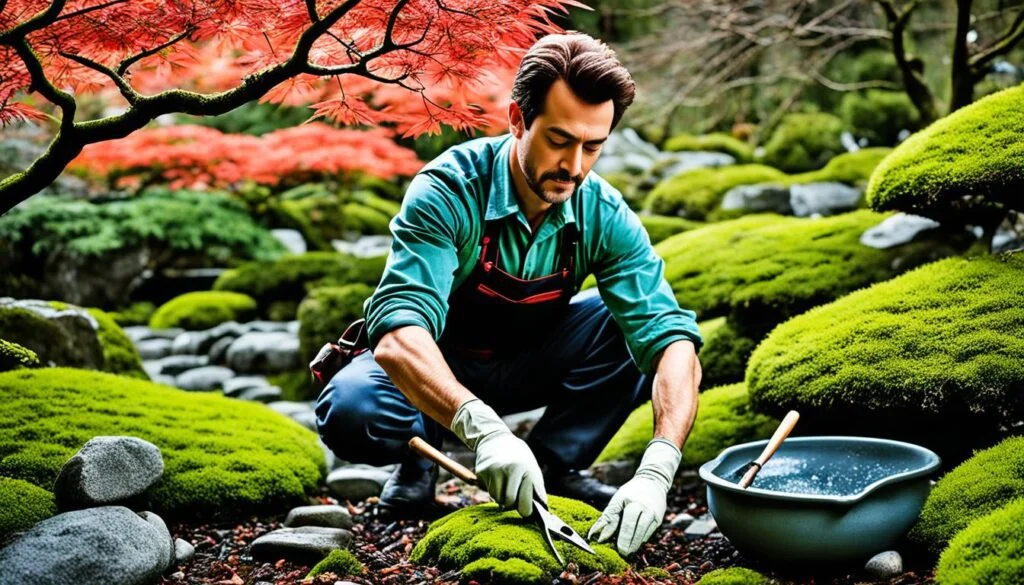
Using these tips in your garden captures the beauty of places like the Anderson Japanese Gardens. It also respects the deep care Japanese culture has for gardens.
Pulling weeds or raking gravel becomes a journey of discovery and a deep appreciation for the silent language of nature.
Preserving the Health and Aesthetics of Non-Plant Elements
In a Japanese garden, non-plant elements like pathways, rocks, and water features are vital. They complement the garden’s plants and need regular care and gentle fixing. This keeps the garden’s beauty intact.
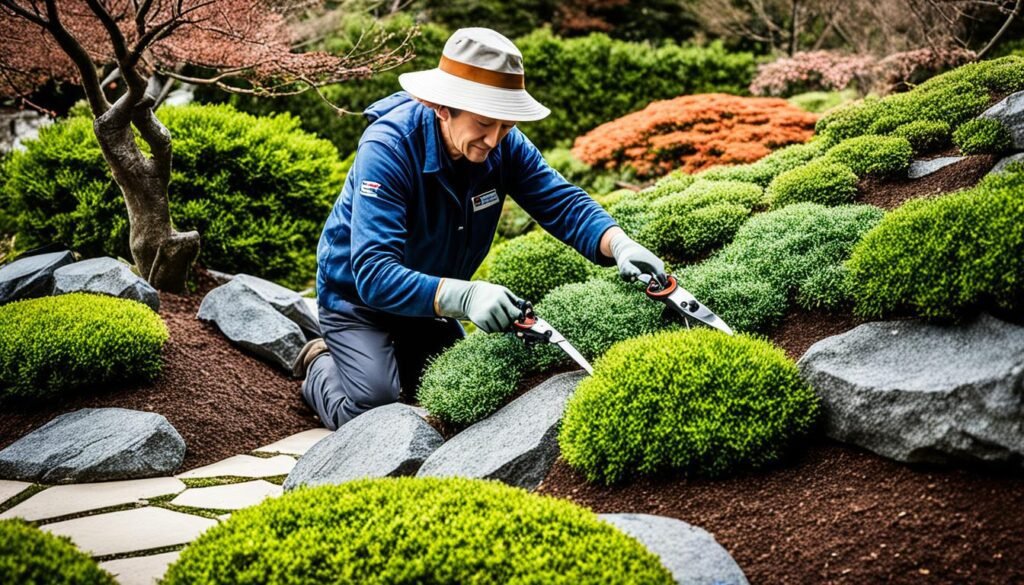
In a Japanese garden, small details matter a lot. The beauty of non-plant elements comes from cleaning and understanding their history. They tell stories and add depth to the garden.
Up keeping these pieces helps them stand the test of time and weather. It also keeps the garden’s aesthetic balance, offering visitors an authentic experience of nature’s beauty.
Care for every stone, every path, and every drop of water as you would the most delicate of flowers, and your garden will tell its story beautifully.
- Rocks and gravel must be clean and free from moss to not lose their shape or make the garden look untidy.
- Bridges and benches made of wood need checks and fixes to stop them from decaying and to keep them safe.
- Water features must be clean. This keeps them beautiful, helps them mirror the sky and plants, and supports life in the water.
Looking at how places like the U.S. Botanic Garden care for their features can show the level of effort needed. Both plant and non-plant elements require dedicated maintenance to stay beautiful.
| Feature | Material | Maintenance Requirement |
|---|---|---|
| Pathways | Stone, Gravel | Cleaning, Weeding, Leveling |
| Rocks | Natural Rock | Algae/Moss Removal, Positioning |
| Water Features | Stone, Mortar | Water Treatment, Debris Clearance |
| Wooden Structures | Cedar, Cypress | Sealing, Replacement of Damaged Parts |
The importance of maintaining Japanese garden non-plant elements is huge. Caring for them is as essential as for the garden’s plants. This effort keeps your garden peaceful and beautiful for years.
Regular Maintenance of Water Features
Japanese garden water features add tranquil beauty to your landscape. They are central to the design of a Japanese garden. To keep them serene and clear, regular care is a must. We’ll talk about how to keep your garden’s water features in great shape and ensure aquatic life thrives.
Safe Cleaning Treatment Tips
It’s crucial to keep your water features clear of algae and debris. A gentle cleaning routine helps maintain the balance of your ponds or streams.
Start by removing visible debris with a fine-mesh net. To fight algae, add water plants that battle it for nutrients and sunlight. Gently scrubbing the rocks and sides with the right brushes helps too, without harming the water’s ecosystem.
If you’re looking for tips on elements of a Japanese garden, use chemical treatments carefully. They should be safe for fish and plants.
Regular care means cleaning and checking water pH and clarity. This keeps the water looking great and maintains healthy conditions for fish and plants.
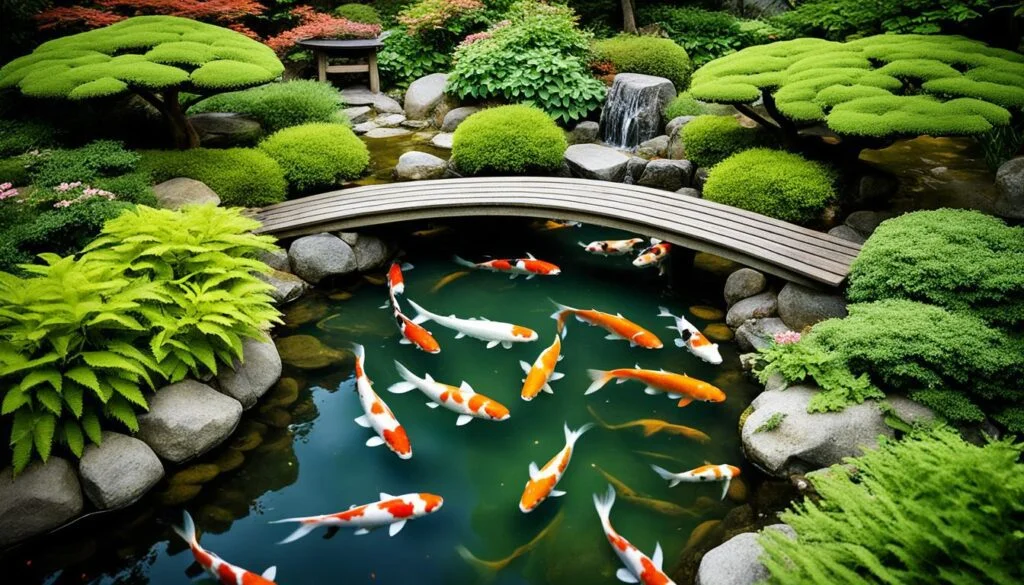
Caring for Fish and Aquatic Life
Looking after fish in a Japanese garden, like goldfish or koi, is rewarding but vital. Make sure fish have a balanced diet and plenty of shelter.
Plants such as lilies provide necessary shade and protection. Getting ready for winter is crucial too. A de-icer keeps part of the pond open for gas exchange.
- Regularly check the filter system and clean or replace it as needed to maintain a healthy environment.
- Test the water for appropriate levels of nitrates, ammonia, and pH to keep conditions optimal.
- Aerate the water to ensure adequate oxygen levels, especially important in warmer temperatures.
By following these tips, your Japanese garden water features will flourish. They’ll offer a peaceful view and support diverse life.
Optimizing Your Japanese Garden’s Irrigation System
A Japanese garden balances nature. Studies show these gardens boost health by connecting us with nature. An optimized irrigation system keeps your garden lush and peaceful. It helps your plants thrive and keeps stress at bay.
A good irrigation system for a Japanese garden can spot leaks and check water pressure. This keeps your garden’s ecosystem healthy and looks pretty. The sound of flowing water from a well-regulated system adds to the garden’s soothing feel.
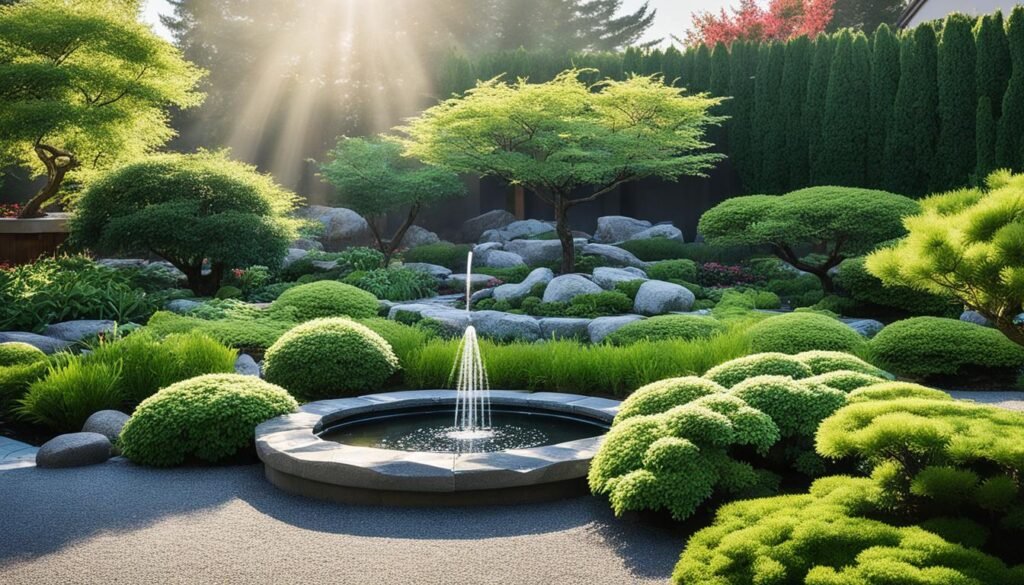
Performing Biannual Irrigation Checkups
Biannual checkups on your irrigation system follow nature’s cycles. They ensure everything, from tea herbs to ornamental grasses, gets just the right water. These checkups also help your garden attract life, like butterflies and birds.
Monitoring Water Pressure and Detecting Leaks
Managing water right means keeping an eye on pressure to protect plants and paths. Fixing leaks fast stops water waste and keeps your garden perfect. A well-kept irrigation system makes your garden a place for reflection and peace.
| Feature | Function | Benefit |
|---|---|---|
| Biannual Checkups | Assess and adjust irrigation components | Ensures plant health and water efficiency |
| Water Pressure Monitoring | Regulate flow to suit garden design and plant needs | Prevents damage to plants and hardscape elements |
| Leak Detection | Identify and repair system breaches | Conserves water and avoids over-saturation |
To build a healing garden that calms and promotes health, use these tips. By keeping your Japanese garden’s irrigation in top shape, you make a peaceful retreat. Enjoy the serenity of your garden, knowing you have a great irrigation system backing it.
Effortless Japanese Garden Upkeep: Outsourcing Maintenance
Not everyone has the time or skills for Japanese garden care. Hiring professionals for garden maintenance is a peaceful answer.
Imagine having a perfect Japanese garden, with no effort from you. Experts can keep every plant and pond in excellent condition. Hiring them keeps your garden looking great and feeling peaceful.
Using a garden care service can change how you enjoy your garden. You won’t have to work in it anymore.
Maintenance teams know how to care for everything, including bonsai trees. They provide services that fit exactly what your garden needs. This lets your special garden be the best it can be.
Choose a reputable Japanese garden maintenance provider. Look for someone with real respect and knowledge of these gardens.
The right service will show their skill and care in their work. This ensures your garden stays beautiful and peaceful for you to enjoy.
FAQ
What are some essential tips for maintaining a Japanese garden?
To keep a Japanese garden looking great, it’s key to understand its design principles. Aim for harmony using simple elements. Balancing open spaces is also critical.
Keep the non-plant parts of the garden healthy. Regularly check water features and the irrigation system. You might even think about hiring experts for help.
What is the philosophy behind Japanese garden design?
The philosophy of Japanese gardens comes from Buddhist, Shinto, and Taoist beliefs. These gardens are meant to bring peace and closeness to nature. They use water, plants, rocks, and clean shapes to make a calming space.
How can I create harmony with minimalist elements in my Japanese garden?
Creating harmony involves smart placement of rocks to represent mountains and islands. Include water features like ponds for tranquility. Topiaries add a touch of elegance.
How can I master the balance of open space in my garden?
Balancing open space means considering how the garden looks from various places. Use steppingstones and paths to enhance the journey through the garden. This approach deepens the sense of discovery.
What is involved in maintaining a Japanese garden?
Upkeep of a Japanese garden requires attention to both plants and non-plant features. This means regular watering, weeding, pruning, and cleaning to keep it beautiful and healthy.
How can I preserve the health and aesthetics of non-plant elements in my Japanese garden?
Keeping non-plant parts healthy involves cleaning rocks and pathways. Care for water features and ornamental pieces to maintain the garden’s beauty.
How do I maintain water features in my Japanese garden?
For water feature care, clean regularly to avoid algae and debris. Look after the fish and aquatic life for their health.
How can I optimize my Japanese garden’s irrigation system?
Optimizing the irrigation system means doing checks twice a year. Watch the water pressure and check for leaks to protect your plants.
Can I outsource the maintenance of my Japanese garden?
Yes, you can hire professional garden care services. They ensure your garden stays beautiful easily.
Source Links
- https://www.bbg.org/article/authenticity_in_japanese_landscape_design
- https://danslegris.com/blogs/journal/japanese-zen-garden
- https://www.dreamzar.app/post/creating-tranquility-exploring-the-beauty-of-japanese-zen-gardens
- https://www.news-herald.com/2021/10/27/bringing-nature-in-japanese-gardens-speak-to-the-moment/
- https://nehomemag.com/mastering-the-timeless-art-of-japanese-design-indoors-and-out/
- https://www.bhg.com/gardening/design/styles/elements-of-a-japanese-garden/
- https://apnews.com/article/lifestyle-japan-environment-and-nature-united-states-gardening-d209b32457d51fdc9ddf9255163992cd
- https://www.usbg.gov/plant-collections
- https://extension.psu.edu/how-to-create-a-healing-garden
- https://www.scad.edu/sites/default/files/PDF/SCAD-Course-Descriptions-info.pdf?23-24







